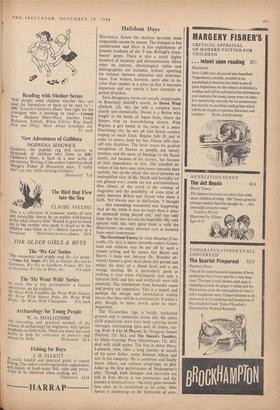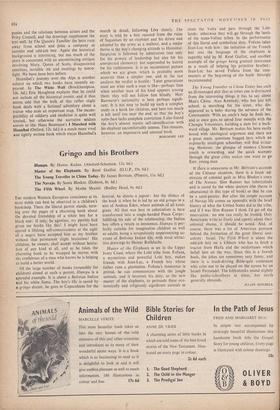Halidom Days
HISTORICAL fiction for children becomes more respectable season by season. The dialogue is less cumbersome and there is less exploitation of famous incidents of the 'I was Raleigh's cloak- bearer' genre. There is also a much higher standard of accuracy and documentation. Often notes on sources, chronological tables and bibliographies are included, without upsetting the balance between education and entertain- ment. Few writers, however, seem able to in- volve their readers in a story so that it becomes important and not merely a bare chronicle or period diversion.
Such derogatory terms are usually inapplicable to Rosemary Sutcliff's novels. In Dawn Wind (Oxford, 12s. 6d.) she tells a complex story clearly and memorably. Owain is a Briton who fought at the battle of Aqua: Sulis, where the Saxons won an overwhelming victory. With Regina, a girl found in the ruins of a once- flourishing city, he sets off into Saxon country hoping to reach Gaul. Regina falls ill, and in order to ensure food for her, Owain sells him- self into thraldom. The book traces his gradual recognition of Saxons as people, not merely enemies, and his sense of bondage to the Saxon family, not because of his slavery, but because of their dependence on him. The unselfish de- votion of the hero may seem more romantic than realistic, but on the whole this novel presents an unsimplified view of life. Death and brutality are not glossed over; events are not sentimentalised. One climax of the novel is the coming of Augustine and the possibility of some kind of unity between Briton and Saxon who share a faith. Yet Owain says in disillusion, '1 thought . . . that something wonderful was happening. And all the .while it was no more than a piece of statecraft being played out,' and can only hope that the two are not incompatible. My only quarrel with this very good book is with the illustrations—so many tortured eyes in haunted faces seem unnecessary.
The Greenland Farers, by Alan Boucher (Con- stable, 12s. 6d.), is about eleventh-century Green- land and children may be put off by such a remote setting and by names like Bjarni and Snorri. I hope not, because Dr. Boucher ob- viously knows a great deal about this period and makes his story of a blood feud and a sea voyage exciting. He is particularly good at evoking a time when Christianity had only a tentative hold and fate and witchcraft were still powerful. The translations from Icelandic runes and poetry are impressive. This is a sequel, and perhaps the abrupt and inconclusive ending means that there will be a continuation. It seems a pity, though, to make novels quite so inter- dependent.
The Elizabethan Age is hardly uncharted ground and it sometimes seems that the entire child population must have been carrying secret messages, intercepting spies and, of course, act- ing. Both A Cry of Players, by Margaret Jowett (Oxford, 12s. 6d.), and The Queen's Tumbler, by Hilda Cumings Price (Heinemann, 12s. 6d.), deal with child actors. The first is about Harry Lulworth, who, after a long journey in search of his actor father, meets Edward Alleyn and acts in his company. He is ambitious and finally leaves Alleyn, not without misgivings, to play Juliet in the first performance of Shakespeare's play. Though both dialogue and narrative are stiff at first—Harry is too precocious and the journey is skimmed over—the story gains momen- tum once he is established as an actor. Miss Jowett is interesting on the formation of com- panies and the relations between actors and the Privy Council, and the drawings supplement the text well. In The Queen's Tumbler the hero runs away from school and joins a company as tumbler and odd-job boy. Again the historical background is interesting, but too much of the story is concerned with an unconvincing intrigue involving Mary, Queen of Scots, disappointed courtiers, invisible ink and meetings by moon- light. We have been here before.
Hannibal's journey over the Alps is another subject on which two books have recently ap- peared. In The White Wall (Brockhampton, 10s. 6d.) Eric Houghton explains that he could not include all the historical events, and it thus seems odd that the bulk of this rather slight book deals with a fictional adventure about a traitor who stole an important map. The incom- patibility of soldiery and medicine is quite well treated, but otherwise the narrative seldom comes to life. Hans Baumann's I Marched with Hannibal (Oxford, Its. 6d.) is a much more vivid and tightly written book which traces Hannibal's
march in detail, following Livy closely. I he story is told by a boy rescued from the ruins of Saguntum by an elephant and his driver and adopted by the army as a mahout, and a major theme is the boy's changing attitude to Hannibal. Suspicion is followed by admiration (not only for his powers of leadership but also for his unexpected clemency), but superseded by hatred for his ruthlessness. It is an inconsistent picture which we are given, which is probably more accurate than a simpler one, and in the last analysis the verdict is hostile: 'Later generations must see what such a man is like—perhaps then when another man of his kind appears among them. they will not follow him blindly. Herr Baumann's nationality is here perhaps signifi- cant. It is not easy to build up such a complex study in a book for children, and here too much is left until too near the end. so that the boy's volte-face lacks complete conviction. I also found the boy's almost mystic self-identification with his elephant uncomfortably intense. This remains, however, an impressive and unusual book.
ROSEMARY LEE











































 Previous page
Previous page